|
Newspapers... At the Production Department :
The printing process
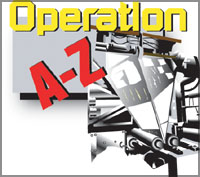 In
our previous article, we enlightened you on newspaper formats, jargon
and staff. Today, as promised, we will bring you some interesting facts
about the pre-press and printing process, that is, what happens at the
editorial level, and then at the press. In
our previous article, we enlightened you on newspaper formats, jargon
and staff. Today, as promised, we will bring you some interesting facts
about the pre-press and printing process, that is, what happens at the
editorial level, and then at the press.
How many of you have visited a newspaper office and observed how the
paper is printed using modern
|
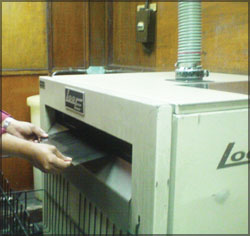
Negatives of pages being taken at the
Image setter |
technology? Those of you who have, would have found it very
fascinating, because one could hardly believe that just a plain reel of
newsprint (or paper) which is at one end of a machine, comes out as a
newspaper, folded too, at the other end...
So, for the benefit of those who have no clue as to how this
operation is done, let's take a peek into the workings of the editorial
and press.
Pre-press process
There may be many of you who contribute to the Junior Observer by way
of drawings and articles. Let's see what happens to all the articles you
send, and also what other contributors and reporters give...
The articles come in many forms; some are typed, some handwritten and
others 'keyed' in or typed using computers and produced as computer
printouts.
These copies are read and those suitable for publication are selected
by the editor or the relevant desk heads of
|
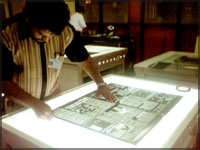
Negatives being coupled as a
double spread. |
the sections and passed on to the sub-editors for editing. The subs,
as they are referred to, not only correct the grammar and spellings,
give headlines, strap lines and blurbs, but also find suitable
photographs or sketches to illustrate the articles and enhance the
layout of the page.
Once these areas are under control, all the handwritten and typed
articles are sent to the Visual Display Terminal (VDT) section for
computer setting.
Next comes the page-make up stage. This is usually done by a graphic
designer or page-make up/layout artist as they are also known.
The pages are designed on a template sent as a document to the
graphic artists via the computer network from
|
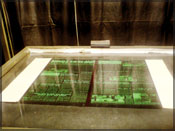
Developing negatives |
the production, marking the areas taken up for advertisements.
The copies or articles and photographs for pages are accessed by the
graphic designers using codes given by the subs. Once the pages are
designed using computer software, computer printouts are taken to
proof-read them for any corrections or changes to be made.
It is only then that the pages are finalised and sent back via the
computer to the Production Department to be stored in page servers.
The Production handles all the technicalities involved in preparing
the pages for printing, by obtaining negatives from the pages sent as
documents by each editorial section.
The negatives are similar to the negatives of photographs. But they
are much larger; the actual size of the
|
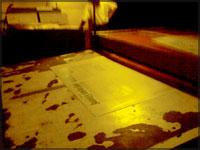
A processed plate |
newspaper. If there are any major errors, especially picture mix-ups
or headline mistakes, they could be spotted and corrected at this stage.
Since the Junior Observer is a full colour paper, four sets of
negatives are taken for the pages in the four basic colours;
cyan,magenta, yellow and black, known as CMYK in short.
In order to get negatives, all the pages in the servers are processed
at the image setting section. Then the negatives or films are 'coupled';
they are put into order because two pages are printed as a double
spread. in one sheet of paper on one side and another two on the
reverse.
They are developed on a layout table. Once this process is completed
and all the pages are sorted out in the
|
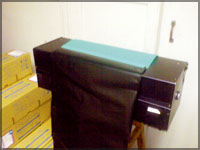
The plate processor |
order they would appear in print, 'plates' are made from the
negatives at the plate making section. Plates are cast out of aluminium
and are chemically coated.
The negatives are placed on a table in a room covered with black
curtains, and imprints of the negatives are made in the plates, using a
purple light. It's similar to developing a photograph. This is a complex
process, so we'll now look into what happens to the plates...
Printing process
|
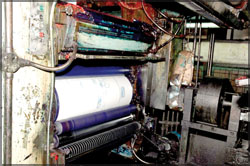
Plates placed on the drum |
The most interesting part in newspaper publishing is the printing
process. The noisiest place at Lake House is the press, where all the
machinery is at work.
Sometimes the noise made by the machinery is like a train picking up
speed. Those of you who have visited a newspaper press would be
certainly familiar with this sound.
Well, getting back to the printing process, there are gigantic
machines that are used to print the different papers. The plates are
placed on what are known as 'drums' on these machines.
There is a special section and staff too that controls the amount of
ink (in the four different colours) released,
|
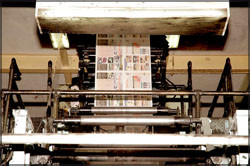
Pages being printed |
for colour printing. Even when it comes to black and white or
non colour printing, the ink is released carefully in order to avoid
smudging.
We will however not go into the intricacies of this particular
process, but can tell you that the pages that are imaged on the plates
are fully printed on the news reel and end up as the news pages you see
in the newspaper you get in the market.
Newspapers are usually printed on inexpensive, off-white paper known
as newsprint. Since the 1980s, the newspaper industry has largely moved
away from lower-quality letter press/printing to higher-quality, four
colour process and offset printing.
|
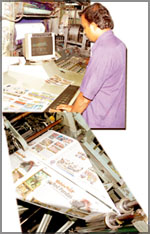
Controlling
the ink |
In addition desktop computers, computer software, graphic software,
digital cameras and digital pre-press and typesetting technologies have
modernised the newspaper production process.
Don't you think the way in which a copy or article you send ends up
as printed matter is
|
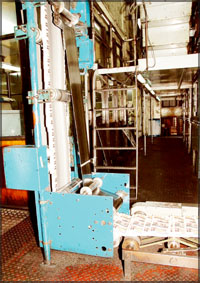
The newspaper rolls out of the machine on a conveyor belt... |
simply amazing?
Why not organise a trip to a newspaper office and check out for
yourselves how a paper is printed because we cannot go into all the
fascinating details in an article?
Besides, seeing it for yourselves would certainly be more interesting
than just reading about it.
Janani Amarasekara |
